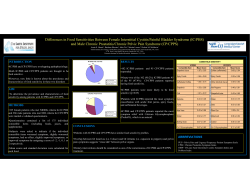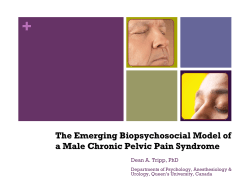
Extracorporeal shock wave therapy (ESWT) for treatment of
Die photodynamische Diagnostik (PDD) des Harnblasenkarzinoms Extracorporeal shock wave therapy (ESWT) for treatment of - Erfahrungen und Bewertungen nach fünfjähriger Anwendung chronic pelvic pain syndrome (CPPS): first results of a Andreas Zumbrägel, Gerhard Feil, Karl-Horst Bichler Klinik für Urologie, Eberhard-Karls Universität Tübingen randomised placebo-controlled double-blind study EAU European Association of Urology Milano 2008 R Zimmermann1, A Cumpanas2, L Hoeltl1, A Stenzl3, F Miclea2 1 Dept. of Urology, Public Hospital, Kufstein/Elisabethinen Hospital Linz, Austria, 2Dept. of Urology, Faculty of Medicine, University of Timisoara, Romania, 3Dept. of Urology, Eberhard Karls-University, Tuebingen, Germany I. Introduction Prostatitis is one of the most frequent outpatient urological diagnoses and results in more than 2 million visits to doctors in the USA annually. The majority of men suffer from the abacterial form of chronic prostatitis or chronic pelvic pain syndrome (CPPS). The quality of life of sufferers can be greatly impaired in particular by sustaining pain, and the restrictions are comparable to those after a heart attack, angina pectoris and Crohn's disease. Symptoms of CPPS are urinary and erectile dysfunction, pain focused in the prostate region as well as perineal, inguinal, scrotal and suprapubic. The pathophysiology of CPPS has not yet been clarified. A psychiatric component may possibly play a role alongside somatic factors, and it has not been possible to demonstrate signs of active infection or bacterial pathogens. Locally, discussions have concerned former infections, changes to the chemical environment, hypertension of the pelvic floor muscles, changes in the blood flow and neurobiological factors. Systemically, obviously prolonged and insufficiently treated acute pain as a negative learning process could cause neuroplastic changes in the central nervous system, with an associated fixation of incurable chronic pain statuses. III. Results Focal area 35-65 mm Therapeutic efficiency 0-125 mm Variable focus Focal area 15-45 mm Therapeutic efficiency 0-105 mm All 60 men completed the treatment, 25 (11 verum, 14 placebo) could be evaluated till now due to complete FU (12 weeks). The mean age was 42.7 years (median 41 y) in a range from 22 – 61 y. Duration of CPPS complaints was on average 7.7 months (3 – 24 ms). Duration of each treatment was 17 minutes. Treatments were well tolerated on an outpatient basis without the need of anaesthesia. Side effects did not occur at all. Pain, CPPS related complaints and quality of life improved markedly after the treatment at the 12 weeks-FU in the verum group which could not be seen in the placebo group. The differences were statistically significant (IPSS p < 0.001, IIEF p = 0.005, CPSI p < 0.001, VAS p < 0.001). penetration depht Focal area 0-30 mm Therapeutic efficiency 0-90 mm Perineal SW approach (transducer positioning for intraprostatic focus) [ IV. Conclusions II. Patients and methods 60 patients with typical CPPS complaints for at least 3 months and no inflammation signs in urine and seminal fluid were included into the study after randomisation. ESWT sessions (focused shock wave, 3000 impulses, 3 Hz, energy density 0.30 mJ/mm2) were performed once weekly for 4 weeks by perineal approach (portable electromagnetic ESWT device, Storz Duolith, Storz Medical AG, Switzerland). For placebo treatment the transducer was modified by an integrated membrane which stopped the spreading of SW. Follow up (FU) was performed after 1, 4 and 12 weeks. Pain was evaluated by visual analogous scale (VAS, 0-10), micturition by international prostate symptom score (IPSS, 0-35), specific complaints by NIH chronic prostatitis symptom index (NIH-CPSI, 0-43) and erectile function by the IIEF (international index of erectile function). Statistical analysis was done by t-test/Mann-Whitney rank sum test. Local chemical alterations Perfusion/ Muscle rigidity Pain memory IPSS CPSI Verum n = 11 Placebo n = 14 Verum Placebo Verum Placebo VAS pre ESWT 16.7 16.8 21.9 25.3 4.1 5.6 post ESWT 12 weeks 12.3 18.2 17.9 26.5 1.7 6.5 Verum Placebo % p= < 0.001 < 0.001 < 0.001 Results of perineal ESWT (Verum vs. Placebo for CPPS treatment with Storz Duolith SD1 This is the first placebo controlled study which proves the statistical significance of ESWT effects for CPPS patients. ESWT of the prostate region is a safe and effective treatment with remarkable release of symptoms. Quality of life could be improved markedly in particular due to pain release. The significant improvement of IPSS is very interesting and will be further investigated. CPPS is probably manifested as myofascial pain syndrome with an abnormal tone of the periprostatic musculature, and a neurological component has become increasingly apparent, associated with dysfunctional effects. The acting mechanisms of ESWT are not yet clarified but may include local changes of tissue perfusion and muscle rigidity, hyperstimulation of nociceptors and influence on neuroplasticity of the pain memory with interruption of nerve impulses. ESWT can be applied easily on outpatient basis also in private office, has no side effects and is very time and cost effective. The duration of the effects has to be evaluated by longer follow up but already now ESWT is almost the only therapy option for CPPS whose efficacy has been proven by placebo control.
© Copyright 2025





















